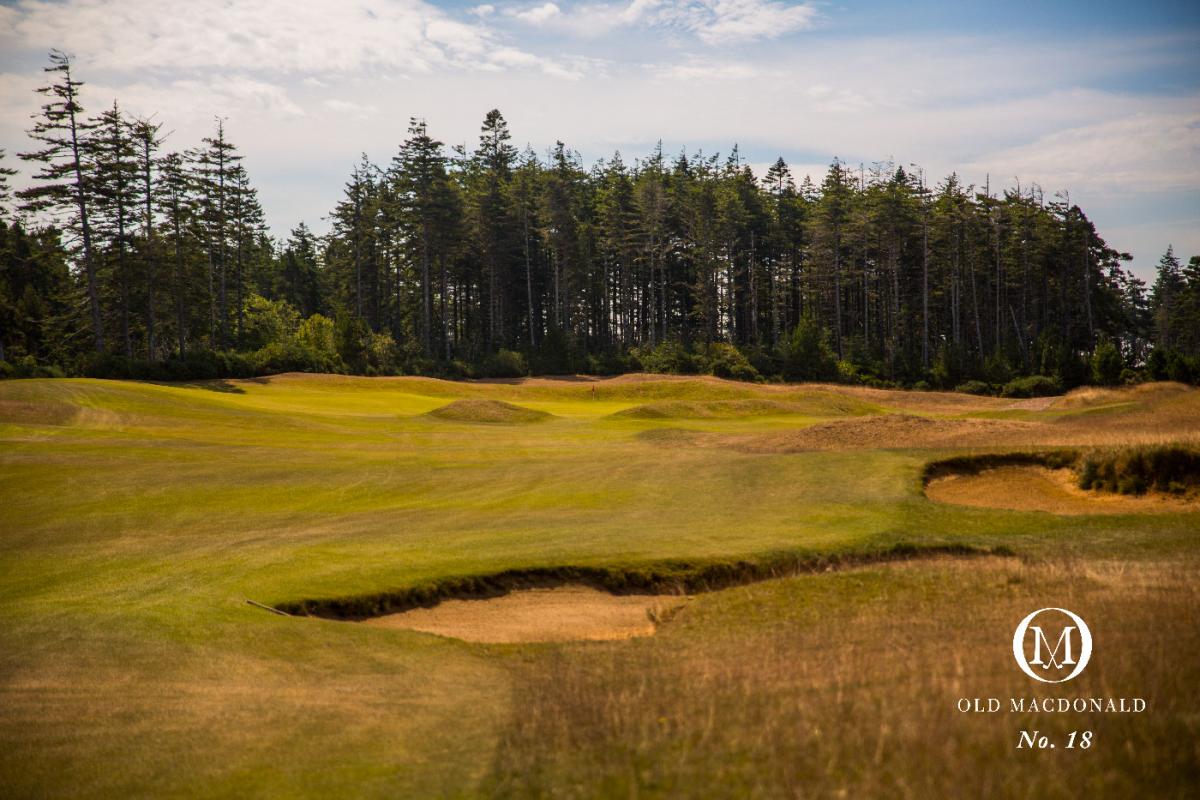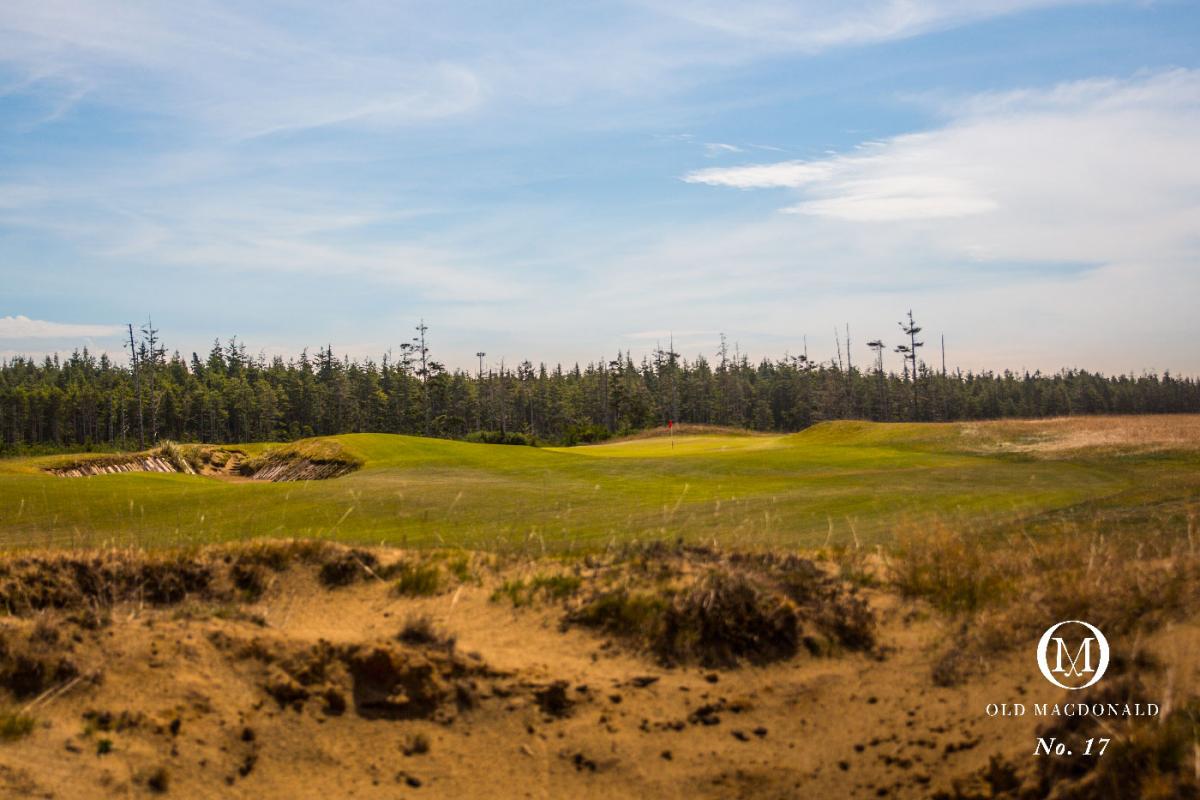Tom Doak’s Hole-By-Hole Description Of Old Macdonald, Back Nine
We've made the turn from last week's hole-by-hole description of the front nine on Old Macdonald. In case you missed Tom Doak's thoughts on holes one through nine, click the link at the bottom of the page! Enjoy the back nine and don't forget to comment on your favorites below!
10. "Bottle” -- As at Macdonald's eighth hole at National Golf Links, two sets of fairway bunkers narrow the driving zone, forcing you to make a carry to the left side of the fairway or funnel into a narrow area in the right side of the hole. The second shot is one of the most difficult on the course, with the green sitting well up above the fairway and not much room through the back; chipping from the base of the green for your third is the best way to avoid a big score, while par is a great score. Precedent: Sunningdale (Old) #12, National Golf Links #8.
11. "Road” -- The line of the fairway and green here are almost identical to the famous Road hole at St. Andrews. Although the tee shot is visible instead of blind, a long drive down the very right of the hole opens up an angle to the green; any approach played from the left or center is threatened by the deep revetted bunker at the left, and a bank falling away at the back right. Precedent: St. Andrews #17, National Golf Links #7, Piping Rock #8.
12. "Redan” -- The most-imitated hole in the world is the par-3 15th at North Berwick, Scotland, known as the Redan, after a Crimean War fortress in Russia which was in the news when it was built. The plateau green runs away from a high shoulder at the right front to the back left, with a deep bunker guarding the left flank of the green. Our Redan is a bit different; the left bunker does not come across the front of the green as far as would be typical for the hole, but the bank of the green feeds short balls out to the bunker. Only a straight fade will work here. Precedent: North Berwick #15, National Golf Links #4, Chicago Golf Club #7.
13. "Leven” -- One of Macdonald's favorite short par-4 holes was at the old Leven Golf Club, whose course has since been split in two; the hole is now the 16th at Lundin Links, Scotland, a few miles south of St. Andrews. The hole is almost drivable, but the green falls away dramatically from the base of a big dune at its front left, down toward the right; so you would like to play your second shot from the right-hand side back up into the slope. Precedent: Lundin Links #16, Chicago Golf Club #5, National Golf Links #17.
14. "Maiden” -- This short par-4 climbing up to an elevated green is named after the famous Maiden at Royal St. George's, the largest dune on any of the Open Championship links. The original Maiden hole was a blind par-3 over the dune which Macdonald sharply criticized, however he admired the size and scale of the hill. The green has elevated wings at the left and back right which demand a precise approach; the nature of the approach can be altered by driving well out to the right, so that the green lays out from front to back. Precedent: none.
15. "Westward Ho!" -- This long par-5 plays back into the setting sun to a green up on the primary dune, overlooking the ocean. The heaving contours of the fairway are like ocean swells; the key shot is the second, which must either get past a deep bunker on the right or be aimed safely short and left of it, which makes the uphill third shot much more difficult. The green is sharply two-tiered, so the correct length of the approach is paramount. Precedent: National Golf Links #18.
16. "Alps” -- Macdonald's third hole at National Golf Links was not just an homage to the Alps at Prestwick, but an improvement on the hole -- instead of making the approach over a dune completely blind, his arrangement of the hole allowed a long drive down the right to get a peek at the green, while allowing a way around the dune for short hitters trying only to play the hole in three installments. Our version is faithful to Macdonald's hole, except that we left a narrow open approach for blind shots from the left, instead of building a bunker all the way across that line as at Prestwick and National. Precedent: Prestwick #17, National Golf Links #3.
17. "Littlestone” -- One of Macdonald's most daring ideas came from the par-4 16th at Littlestone, England. The hole in his day was a long dogleg to the left, but Macdonald imagined an alternate fairway among the dunes on the direct line to the hole, which would enable daring players to cut the corner and get home in two. His version of the hole was the par-5 fourth hole at Lido Golf Club, Long Island, a great course which closed its doors in the Depression. On our seventeenth, driving over a small wetland yields an open approach to the green, but the carry is so long that most players will have to be content with playing away to the left off the tee and taking a three-shot route home. Precedent: Littlestone #16, Lido #4.
18. "Punchbowl” -- Many greens on Scottish links were hidden away in natural bowls between the dunes. Macdonald had a very stylized version of this concept, with a huge green surrounded by small hills sweeping down from left to right; our home green is an outsized version of the Macdonald concept, so that the scale and drama of the course will stay with you right until the last putt is holed. Precedent: Chicago Golf Club #12, The Creek #6.

Check out the front nine of Old Macdonald (Part One)




















